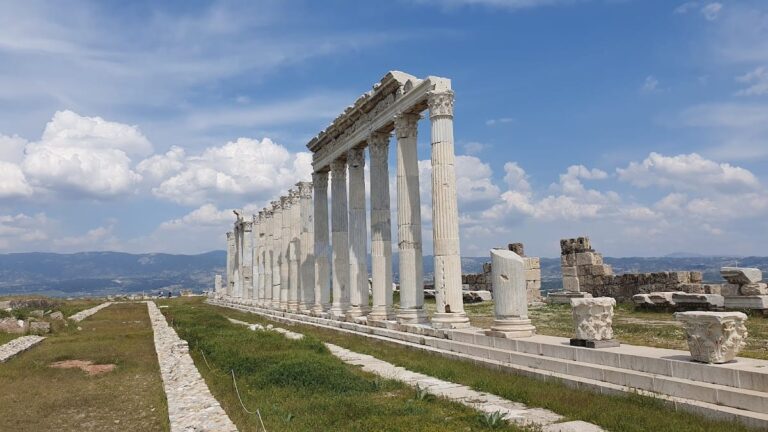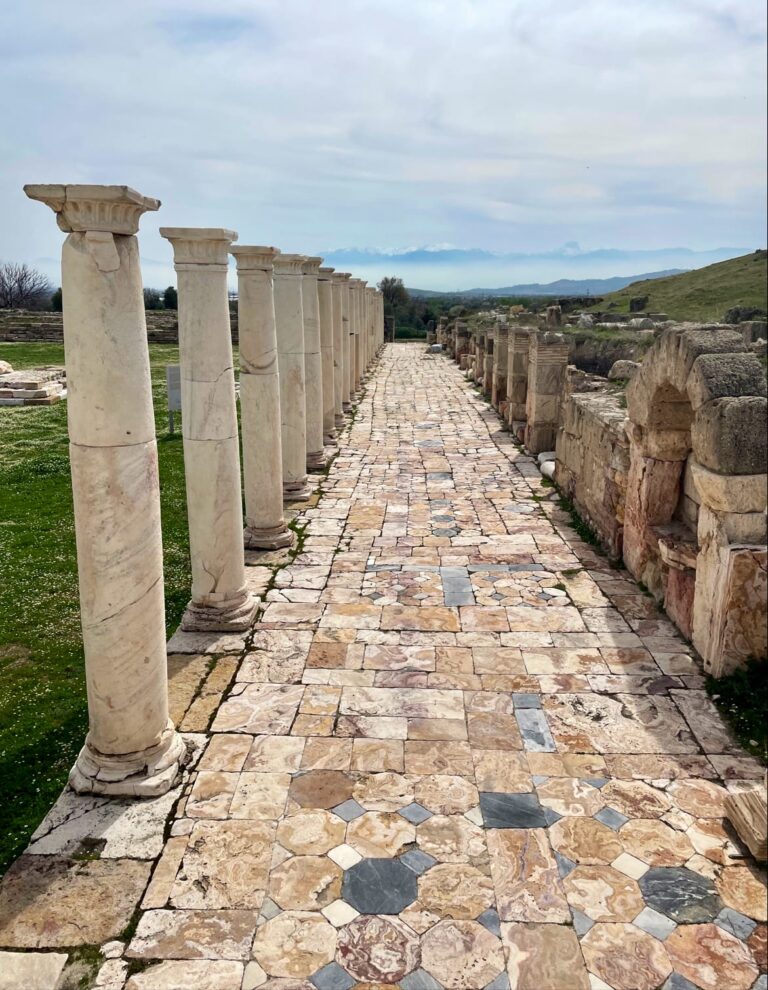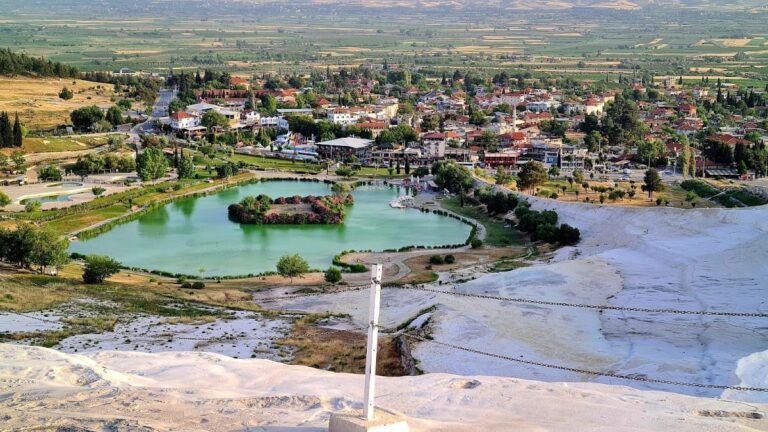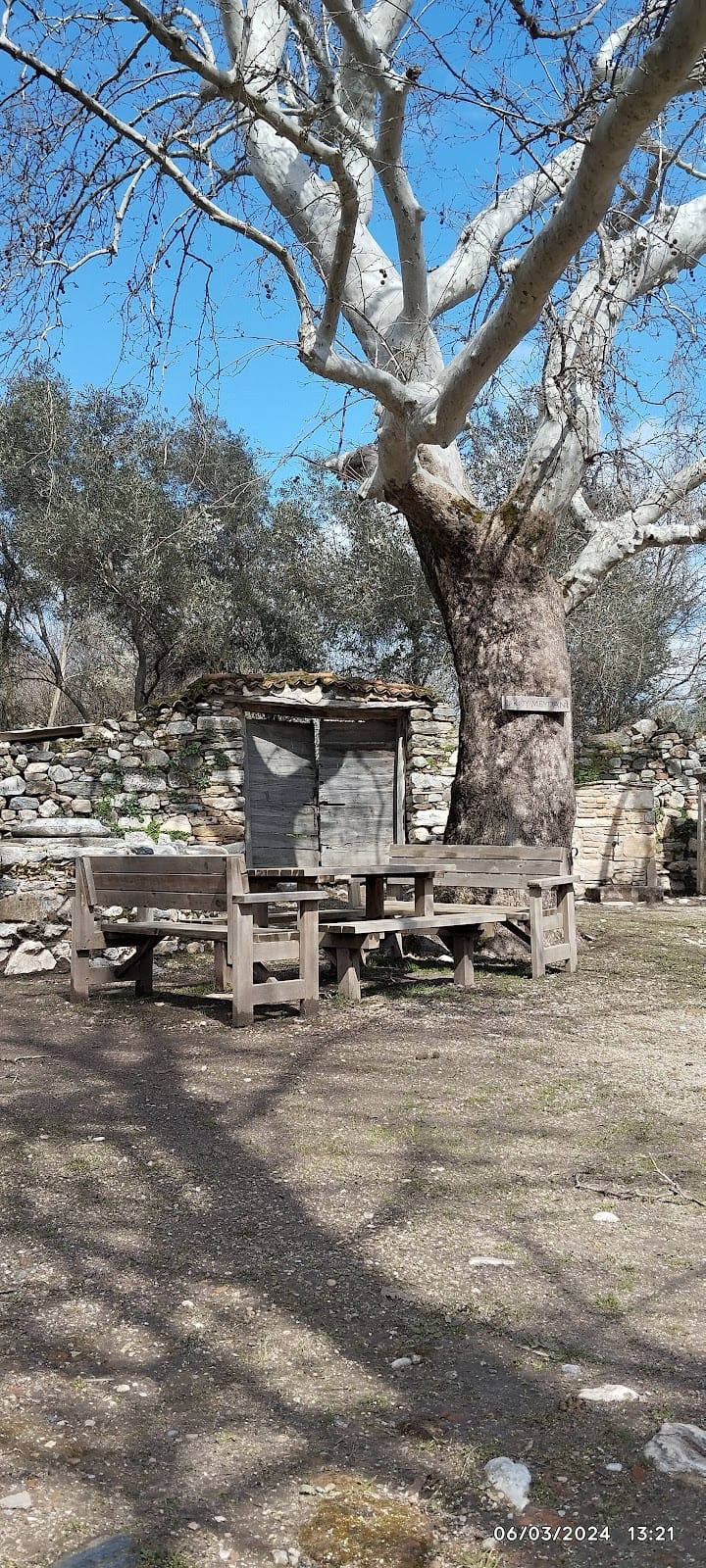Aphrodisias Ancient City
Table of Contents
Exploring the Ancient City of Aphrodisias in Turkey
History
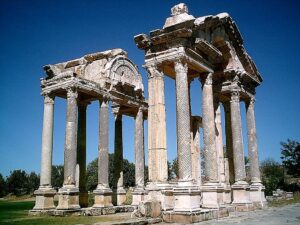 Aphrodisias may be one of the least visited UNESCO world heritage sites in the world. It is located in southwestern Turkey, a little over 200 kilometres from modern Izmir and approximately 100 kilometres from the sea. Like many ancient sites in Turkey, the city features buildings spanning over 1000 years of history.
Aphrodisias may be one of the least visited UNESCO world heritage sites in the world. It is located in southwestern Turkey, a little over 200 kilometres from modern Izmir and approximately 100 kilometres from the sea. Like many ancient sites in Turkey, the city features buildings spanning over 1000 years of history.
Aphrodisias was established as a city-state in the early 2nd century BCE. Initially known by various names, including Lelégōn Pólis and Megálē Pólis, the city was dedicated to the worship of Aphrodite, the Greek goddess of love, whose cult was central to its identity. Aphrodisias was strategically located near valuable marble quarries, which contributed significantly to its growth and prosperity. The availability of this high-quality marble allowed the city to produce renowned sculptures and buildings, which were highly sought after across the Roman Empire.
Early History and Growth
In Greek times the city was unimportant and small, but during the wars with Rome’s archenemy Mithridates of Pontus, Aphrodisias remained unconditionally loyal to Rome, unlike many other cities in the region. Its loyalty signalled the start of a growing and wealthy era for the city.
Roman Influence and Cultural Expansion
By the 1st century BCE, Aphrodisias had gained recognition from Roman leaders, including Sulla, Julius Caesar and Augustus. These emperors granted the city several privileges, including tax exemptions, which further facilitated its growth. Under Roman rule, Aphrodisias reached its peak, becoming an important hub for art and culture, particularly known for its sculpture. The city’s sculptors were highly skilled, and their works were in demand across the Roman Empire. The city’s marble was considered some of the finest, and its workshops produced detailed, lifelike sculptures, many of which were commissioned by wealthy patrons from various parts of the empire.
The city’s Temple of Aphrodite, which had been a key religious structure, was also transformed over time. Aphrodisias remained one of the last standing strongholds of pagan opposition, long after the establishment of Christianity as the empire’s state religion. In the 5th century, the temple was probably ordered to be demolished by emperor Zeno to subdue any remaining opposition. Some of the competition between religious groups can still be seen in the city. Christians have engraved crosses, fishes and prayers in pagan monuments. Pagans in turn responded by engraving a double axe, the symbol of the storm god Zeus. At the end of the sixth century, the city was eventually renamed “The City of the Cross”, marking the final victory of the Christian religion over the old pagan beliefs.
Decline and Transformation
The decline of Aphrodisias began in the 4th and 7th centuries CE, when a series of earthquakes caused significant damage to the city’s infrastructure. These natural disasters, combined with changes in trade routes and political instability, contributed to the city’s gradual decline. Despite this, the city continued to maintain some level of importance throughout Late Antiquity. The renaming of the city to Stauropolis during this period reflects its Christianization, signaling the shift in religious practices from paganism to Christianity.
Aphrodisias also faced invasions, notably by the Seljuk Turks in the late 12th century, which further weakened the city. Although it remained inhabited, its influence and population dwindled over time. The city, once a thriving urban center, was reduced to a much smaller settlement.
Remains
The remains of the city that can still be visited include a stadium, agora, theatre, bathhouses, public fountains and churches. The centre of the city does not follow the usual Roman grid pattern, since it was established in Greek times. With the arrival of the Romans city planning also changed, as can clearly be seen from the grid pattern established for the outskirts of the city once the city started expanding.
City plan. Arrow shows position of Troilos base in tower in north Wall. (Drawing: H. Mark)
Monumental Gateway (Tetrapylon)
The monumental gateway, known as the tetrapylon, dates to around 200 CE and serves as the entrance to the Sanctuary of Aphrodite. The tetrapylon consists of four towering columns, carved with reliefs and ornamental features. Its design incorporates both decorative and functional elements, guiding visitors into the sacred precinct. The surviving remains of the tetrapylon reflect the high level of craftsmanship in Aphrodisian stonework, which was renowned throughout the Roman Empire.
The Temple of Aphrodite
The Temple of Aphrodite was originally constructed in the 3rd century BCE, serving as the focal point of the city’s religious life. Dedicated to Aphrodite, the goddess of love, the temple was a prominent feature of the city’s skyline. In the 5th century CE, the temple was repurposed and transformed into a Christian basilica. The remains of the temple include sculptural fragments, including friezes and architectural elements, which offer insight into the high-quality craftsmanship of Aphrodisian sculptors.
The Bouleuterion (Council House)
The Bouleuterion, or council house, dates back to the late 2nd or early 3rd century CE. This large building functioned as the venue for public meetings, debates, and political gatherings. The Bouleuterion’s design features a semicircular auditorium with a seating capacity of approximately 1,750. The structure’s nine rows of marble seats and shallow stage reflect the influence of Hellenistic traditions in the design of public spaces.
The Sebasteion
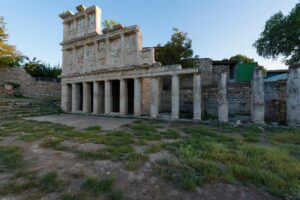 The Sebasteion is a cult complex dedicated to Augustus and Aphrodite, built around the 1st century CE. The structure features a series of reliefs depicting imperial figures, including Augustus, in scenes of sacrifice and offering, symbolizing the connection between the emperor and the local goddess Aphrodite. The reliefs in the Sebasteion emphasize the integration of imperial power with local religious traditions, reinforcing the city’s allegiance to Rome.
The Sebasteion is a cult complex dedicated to Augustus and Aphrodite, built around the 1st century CE. The structure features a series of reliefs depicting imperial figures, including Augustus, in scenes of sacrifice and offering, symbolizing the connection between the emperor and the local goddess Aphrodite. The reliefs in the Sebasteion emphasize the integration of imperial power with local religious traditions, reinforcing the city’s allegiance to Rome.
The Stadium
 Aphrodisias is home to one of the best-preserved stadiums of the ancient world, which measures approximately 270 meters by 60 meters. This large arena could accommodate around 30,000 spectators, a testament to the city’s capacity to host major public events, including athletic competitions and gladiatorial games. The stadium’s design is notable for its amphitheatral form, which follows the natural contours of the surrounding landscape. This allows for a more intimate yet grand viewing experience, where the audience could engage closely with the events. The stadium remains an iconic symbol of the city’s role in the cultural and sporting life of the Roman Empire, and its preservation provides a rare opportunity to study ancient stadium construction.
Aphrodisias is home to one of the best-preserved stadiums of the ancient world, which measures approximately 270 meters by 60 meters. This large arena could accommodate around 30,000 spectators, a testament to the city’s capacity to host major public events, including athletic competitions and gladiatorial games. The stadium’s design is notable for its amphitheatral form, which follows the natural contours of the surrounding landscape. This allows for a more intimate yet grand viewing experience, where the audience could engage closely with the events. The stadium remains an iconic symbol of the city’s role in the cultural and sporting life of the Roman Empire, and its preservation provides a rare opportunity to study ancient stadium construction.
Inscriptions and Sculptural Works
Aphrodisias has yielded over 2,000 inscriptions, which provide insight into the city’s social and cultural dynamics. The quality of Aphrodisian marble has contributed to the excellent preservation of numerous sculptural works, such as portrait busts and statues. These sculptures often depict emperors, gods, and notable citizens, reflecting the city’s artistic traditions and its connection to Roman imperial culture. The marble, known for its purity and consistency, allowed sculptors in Aphrodisias to achieve a level of detail and realism that set their work apart in the ancient world.
Excavations and Ongoing Research
Formal excavations at Aphrodisias began in the early 20th century, and research continues to this day, providing new insights into the city’s architectural and artistic history. The ongoing excavations reveal more about the urban layout, the city’s role in the Roman Empire, and its transition from a pagan city to a Christian one. The archaeological efforts have uncovered not only monumental structures but also everyday items that illuminate the daily lives of Aphrodisians.

